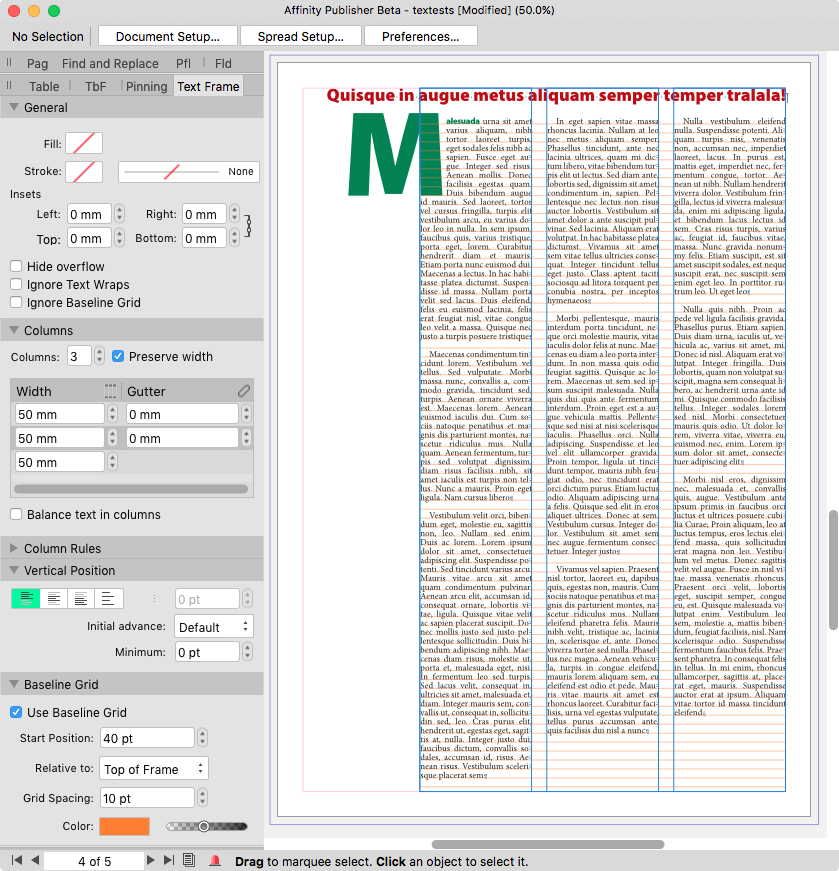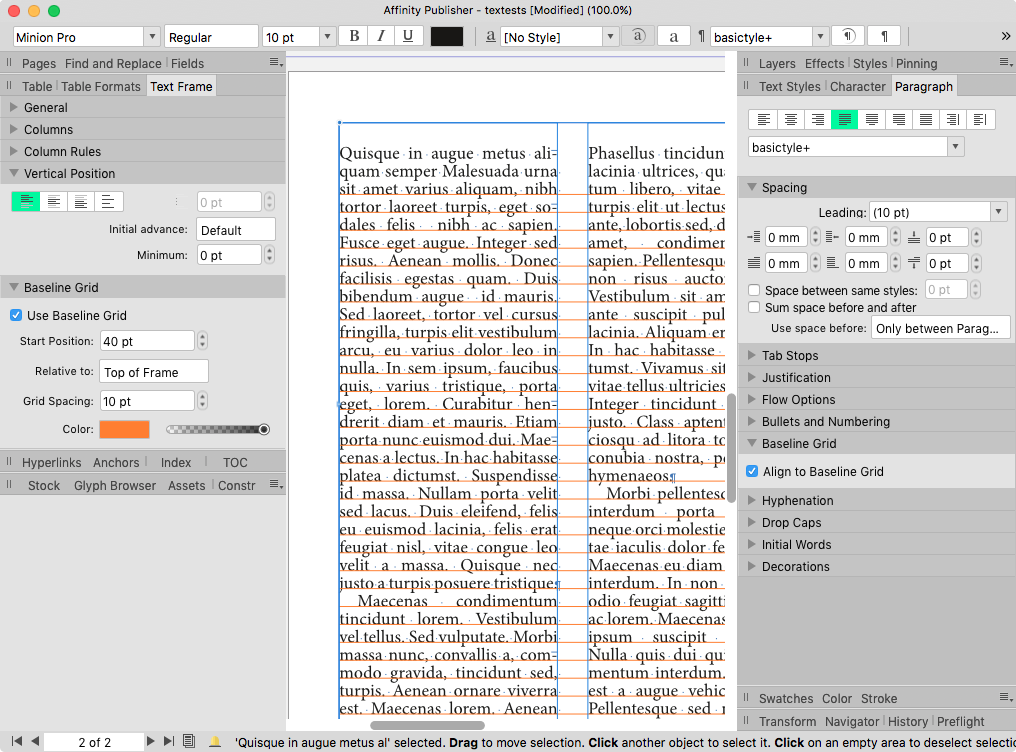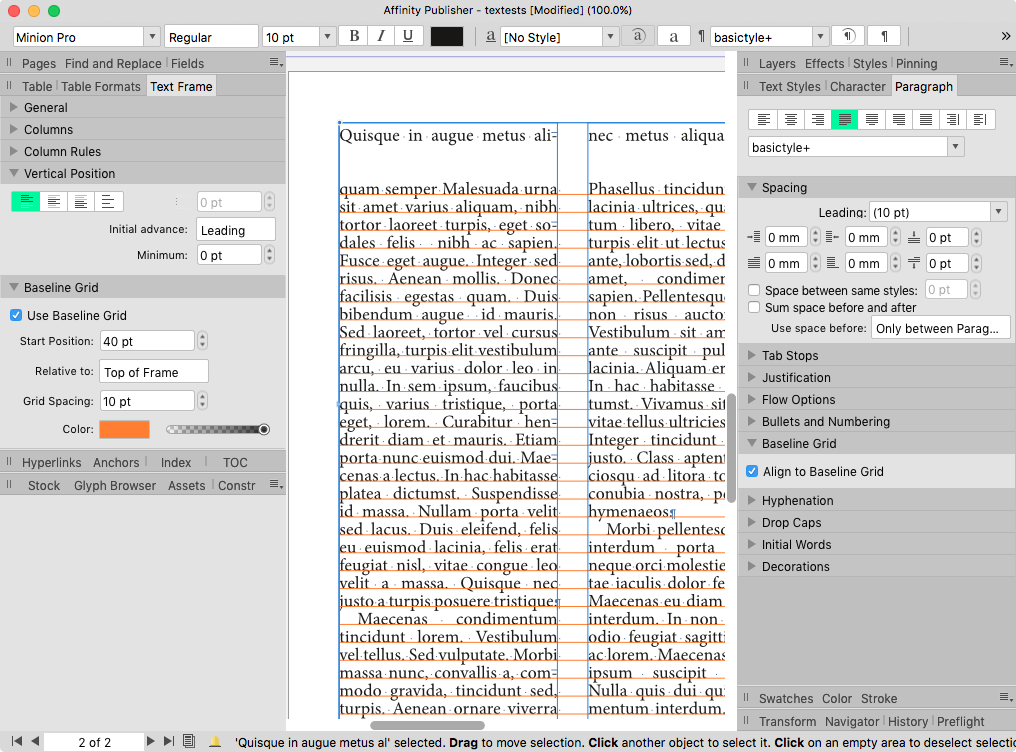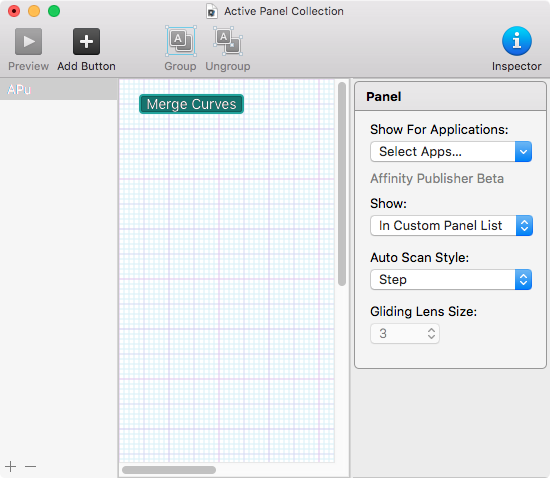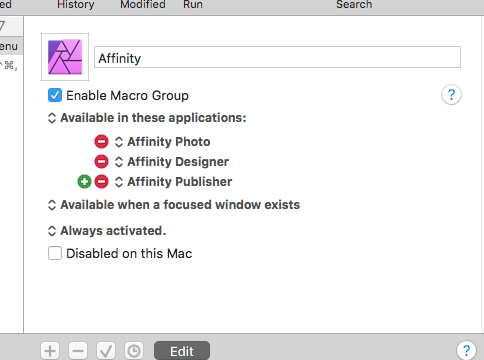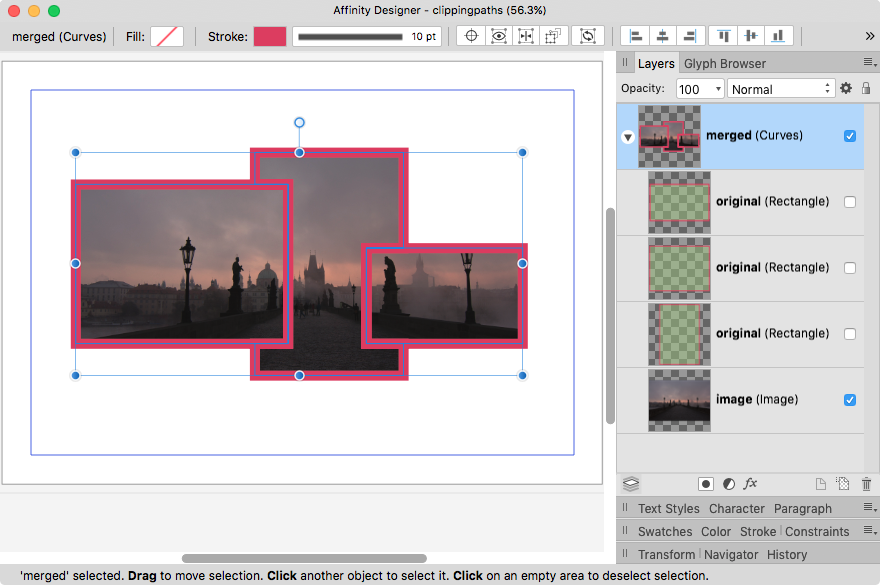-
Posts
6,949 -
Joined
Everything posted by loukash
-

v.1.9 fails to honour first baseline in grid
loukash replied to beast's topic in V1 Bugs found on macOS
Not if you want to have a fake span column. See forum.affinity.serif.com/index.php?/topic/64963-span-columns/&do=findComment&comment=733694 ff. (and also the earlier posts) But even in my previous example, Break Before Paragraph Only At Column Top in addition to the Keep Paragraph Together attribute was necessary to work around the grid start position bug. Me too. Back in the day, (re)creating paragraph decorations – which the original designer had always positioned manually as plain lines and rectangles – as inline text styles in XPress 4 was pretty tricky to begin with. But then, laying out each brochure with a few shortcuts became so much faster… And then, CS5… span columns… oh well. -

v.1.9 fails to honour first baseline in grid
loukash replied to beast's topic in V1 Bugs found on macOS
Yes, if you don't want anything above the main text. But the point of having a reliable baseline grid start position is that you can do pretty neat tricks with it, e.g. a headline span (!) at the top with all text still running linear in one single frame, fully editable. Here the exact start position only works because of Flow Options > Keep Paragraph Together as a compromise workaround: The right alignment of the headline as well as the drop cap position needs to be tweaked individually based on the length and size respectively, but other than that it's all based on text style rules. Fun stuff. Some of these tricks like text running outside the frame aren't even possible with InDesign CS5.5 – don't know about the CC versions though. -

v.1.9 fails to honour first baseline in grid
loukash replied to beast's topic in V1 Bugs found on macOS
… and that's exactly what @beast eventually did: -

Default location for Save As (and Export)
loukash replied to p10n's topic in Feedback for the Affinity V2 Suite of Products
Just to clarify: I was talking about the "Folder Sets" feature in the Default Folder app, not an actual folder hierarchy on the drive. -

v.1.9 fails to honour first baseline in grid
loukash replied to beast's topic in V1 Bugs found on macOS
I don't know what exactly @beast wants to achieve, but… Why not? What do we know about what else they have in mind with their layout? The app should simply follow orders. In any case, the baseline grid implemetation and behavior consistency in APu still leaves a lot to be desired, that's for sure. But perhaps it's just me and my "high expectations" after relying on PageMaker's, Xpress's and InDesign's baseline grids for the past 30 years… In theory: yes. In practice: not really. The orange grid is where this paragraph style should start, but does not. And that's a bug, not a feature: -
Ah, that was easy: gs -sDEVICE=tiffsep -o /path/to/output/folder/output%d.tif -r300 /path/to/input/file/affinity_pdfx3_export.pdf %d in output filename = page number And if you need a real "%" in filename, escape as "%%". And on Win console apparently you must always escape every % as %% or something. But read the ghostdocs for yourselves. Also recommendable, among others, a switch for subpixel antialiasing of text. Available values n = 1, 2 or 4: -dTextAlphaBits=n More as it develops some time next week…
-

Para style for first lines
loukash replied to pcdlibrary's topic in Feedback for Affinity Publisher V1 on Desktop
And frankly, I still do like InDesign. I just don't like Adobe's business model. So they won't get my money anymore. CS5.5 still runs alright on El Capitan, but if I ever move on to Catalina for good, I'll want to be using Affinity full time. Hence I'm trying to get used to it as far as possible, inventing and adapting new workflows while attempting to "reprogram" my crusty "Adobe mindset". Currently I'm also testing solutions to create CMYK separations from Affinity PDF/X output via Ghostscript to mimic one of the very few advanced control functions I'm occasionally needing Acrobat X for. -

Para style for first lines
loukash replied to pcdlibrary's topic in Feedback for Affinity Publisher V1 on Desktop
I started in 1989 with Aldus PageMaker 3 that some good soul installed on a freely accessible Macintosh SE/30 in a public university library. They also had 300 dpi LaserWriter, so that was where I laid out my first pages, without any experience in computer – let alone DTP – whatsoever because earlier that decade at the art school, we'd still learned everything the "old school" by hand. Later I also worked on PM 4.2 and went through XPress 3 & 4 as well as my beloved Freehand 9, until InDesign 2 came along. That was a relief! And it ran on OS X! -
Fair enough, so back on topic: Frankly, not really. Simply because this is a system function. Apps that are modifiying keyboard input on the fly – like karabiner-elements.pqrs.org that I'm also using since many years – need to do quite some low level things that I don't fully understand. Is it worth the investment of developer time when there's still so many things we also want? (Like, er, bug fixes? ) What I'd rather like to see first is the option to set custom modifiers for all these mouse actions: E.g. even though there's now also the "Mac-standard" option-drag to duplicate, at the same time it disables snapping! So if you want to snap, you still have to remember to use cmd-drag anyway…
-

Default location for Save As (and Export)
loukash replied to p10n's topic in Feedback for the Affinity V2 Suite of Products
save folder sets save favorites for each folder set add keyboard shortcuts to favorites save default folders (hence the app name) to each folder set for any particular app you're using in that set switch folder sets from the global Default Folder menu use keyboard shortcuts to browse recent folders or open Finder windows etc… So many possibilities, I haven't even used them all myself. I'm not sure if I actually like that. But perhaps it's just me. In Default Folder, you can create "folder sets" for each client then. Be creative. Having worked with Adobe apps for more than 20 years, rest assured that my own mindset is also locked into their way of thinking. This is not necessarily a Good Thing as far as I'm concerned… -
Each Switch Control panel can be set to work per app, not just globally: Same for Keyboard Maestro: But if you already have Keyboard Maestro or a similar advanced app, then there's not much use for Switch Control which seems pretty basic, unless you really need certain special accessibility assistance.
-
Turn on and off when needed. On Mac: press 5×Shift key System Preferences > Keyboard > Shortcuts > Accessibility > Show Accessibility Controls (activate or assign a shortcut of your choice) ~~~ Also worth to explore while I'm at it: System Preferences > Accessibility > Switch Control That opens quite a few possibilities, e.g. having floating palettes with buttons executing keyboard shortcuts for functions that otherwise don't have buttons, e.g. Merge Curves: (Note that Merge Curves doesn't even have a keyboard shortcut by default. I've opted for cmd-7.) On El Capitan the Switch Control UI is a bit clunky but perhaps it's been more polished on subsequent MacOSs. But for those who don't want to buy Keyboard Maestro, that's yet another possibility to run certain macros with a single click, as you can records several keyboard shortcuts in sequence. Or run a System Events AppleScript to control Affinity beyond existing shortcuts. And I haven't even read the Switch Control documentation yet…
-

Round cutting form
loukash replied to bmjulie's topic in Pre-V2 Archive of Desktop Questions (macOS and Windows)
I have discovered it just yesterday myself. It's there, so when its time has come, I'll see if I can make use of it. An artboard behaves like a global clipping path. That's a Good Thing™. So in ADe, either use a page that's always rectangular, or use artboard(s) that can be any shape and any fill. Great to have a choice. -

Round cutting form
loukash replied to bmjulie's topic in Pre-V2 Archive of Desktop Questions (macOS and Windows)
The cat shape is the artboard shape! The cat being created with the Cat Tool, of course. Again: create any shape you can think of Layer > Convert Object To Artboard Regardless what @bmjulie needs, the "need" can be e.g. not needing to place a filled background object, as the artboard itself provides the background fill and the shape. -

Para style for first lines
loukash replied to pcdlibrary's topic in Feedback for Affinity Publisher V1 on Desktop
Neither do I but it's nice to have when appropriate. And for short documents that I'd usually have to deal with, the workarounds are good enough. -
"If anything else fails, Read The Fine Manual." affinity.help/publisher/de.lproj/pages/Text/dropcaps.html
- 3 replies
-
- affinity publisher
- drop cap
-
(and 1 more)
Tagged with:
-
Open one of the images in Photo, drag and drop the other image files onto the open image. Don't know about Lightroom, but on Mac the drag&drop proxies work from Finder, Bridge, NeoFinder (if these are catalogs of existing local files), GraphicConverter browser, heck, even from the antique iView/Expression Media. For some highly illogical reason, drag'n'dropping an image proxy onto the Layers panel will open it in a new tab. Doesn't make any sense whatsoever but duh. You also can't drag'n'drop a layer from one Photo document onto another. Another duh. Copy & paste layers works though. That process eats a lot of CPU on my aging MacBook, however, so a cautious hooray.
-

Round cutting form
loukash replied to bmjulie's topic in Pre-V2 Archive of Desktop Questions (macOS and Windows)
Add an artboard fill and export the whole content as an image with transparent background. For instance a UI mockup as PNG. Besides, any vector object can be converted to an artboard: -

Para style for first lines
loukash replied to pcdlibrary's topic in Feedback for Affinity Publisher V1 on Desktop
Yep, I like it, too. But it hasn't been there all the time either: it came with CS4. Having skipped that version myself – this being one of the few features I would have really liked to have – and upgraded from CS3 to CS5.5, I didn't get it until late 2011, after more than 10 years of working with InDesign. Until then, I'd be using workarounds with InDesign 2 (not CS) and CS3 as well, just like all of us. The APu workarounds for the time being – until they implement it as a "big feature" some time in the long distance future – are: Define an invisible end character with Initial Words and tweak each paragraph manually Use a character style with a keyboard shortcut, jump with keyboard shortcuts from paragraph begin to end of line, apply character style, jump to next paragraph begin etc. If you have a macro utility like Keyboard Maestro, you can combine those shortcuts into one macro shortcut, or run a full macro loop that will process the whole text in one go. …? (fill in your own ideas here… ) -

Default location for Save As (and Export)
loukash replied to p10n's topic in Feedback for the Affinity V2 Suite of Products
I hate to repeat myself, folks, but: Hence: … if you don't like it. I've done that over a decade ago and never looked back. -
To get this exact form: duplicate the two front rectangles use them to subtract from the back rectangle select all three curves Layer > Geometry > Merge Curves to get a single merged rectangle object drag the image inside the object in Layers panel, or cut the image > paste inside (@Serif staff: Why is "Merge Curves" buried inside a submenu and doesn't have its own toolbar button?!)
-
v1.9.1.0, fresh app preferences & app support files, no other extras El Capitan, MacBook Pro 9,1 create a few objects option click or option select a boolean operation to create a compound click on a blue Compound icon in the Layers panel crash (sometimes just an "internal error" message if enabled) Also affects APh & APu! Not affecting v1.8.4. ADe1910crash20210214.txt.zip
-
That will only work as long as the open side of the triangle doesn't tangent the circle, i.e. at this proportions ca <100°. If you open up the angle to 180°, there will be no circle visible at all. For more flexibility and wider angles, I'd use the pie tool as already noted above, align the prolonged angles manually and group both objects.
- 8 replies
-
- shapes
- shapes subtraction
-
(and 2 more)
Tagged with:


